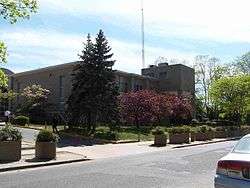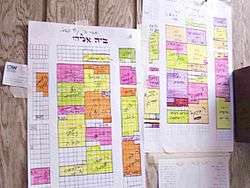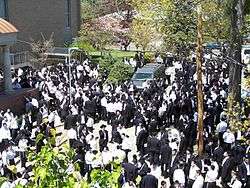Beth Medrash Govoha
|
בית מדרש גבוה | |
 The original Beis Medrash Building of Beth Medrash Govoha | |
| Type | Private |
|---|---|
| Established | 1943 |
| Affiliation | Orthodox Judaism |
| Students | 6,500 (Fall 2012)[1] |
| Location |
Lakewood, NJ, USA 40°05′44″N 74°13′19″W / 40.0955°N 74.222°WCoordinates: 40°05′44″N 74°13′19″W / 40.0955°N 74.222°W |
| Campus | Urban |
Beth Medrash Govoha (Hebrew: בית מדרש גבוה, lit: Higher, or advanced, House of Study) is a Haredi yeshiva and kollel located in Lakewood, New Jersey. It is commonly known as BMG, or Lakewood Yeshiva.
As of 2012, the yeshiva has 6,500 married and undergraduate students,[1][2] making it the largest yeshiva in the United States[3] and one of the largest yeshivas in the world. Over the years, the roshei yeshiva of BMG have all been associated with the Kotler family, beginning with Rabbi Aharon Kotler from 1943 until his death in 1962; Rabbi Shneur Kotler, his son, who led the yeshiva from 1962 until his death in 1982; and the present roshei yeshiva, Rabbi Malkiel Kotler (son of Harav Shneur Kotler), Rabbi Dovid Schustal (son-in-law of Harav Shneur Kotler), Rabbi Yerucham Olshin and Rabbi Yisroel Neuman (sons-in-law of Rabbi Dov Schwartzman).[1] Rabbis Olshin, Schustal and Neuman are married to grandchildren of Rabbi Aharon Kotler. The CEO of the yeshiva is Aron Kotler, the brother of Harav Malkiel Kotler and a grandson of Harav Aharon Kotler.
To manage the huge enrollment, the four roshei yeshiva divide up the times they deliver shiurim (Torah lectures) in the various battei medrash (study halls) on campus.[4] There are also 240 roshei chabura (heads of small study groups) who guide and encourage groups of students in the yeshiva's trademark style of independent learning.[5]
History
Beth Medrash Govoha was originally established as a kollel in White Plains, New York by Rabbis Nosson Meir Wachtfogel, Shmuel Schecter, and Hershel Genauer, alumni of the Kelm Talmud Torah in Lithuania.[6] Established in spring 1942, it was the first kollel in the United States,[6][7] and had 20 members.[7] When Rabbi Aharon Kotler came to New York from Europe in 1943, the kollel members asked him to lead the institute. Rabbi Kotler agreed on the condition that it be moved to Lakewood and expanded with a yeshiva gedola, which opened with an initial enrollment of 14 students.[7][8]
Description
The campus consists of four main buildings containing over eight study halls and numerous residence halls.
The newest building was completed in the summer of 2015, on the land where Bais Eliyahu (the "trailers") used to be. It was first used on Rosh Hashanah 5776, seating over 1000 people for the services.The building was sponsored by Ralph Herzka and Meir Levine.
The yeshiva is licensed by the New Jersey Commission on Higher Education and accredited by the Association of Advanced Rabbinical and Talmudic Schools.[9] It is authorized to grant bachelor's and master's degrees in Talmudics, as well as two post-master's diplomas in Talmudics. What students seek in Beth Medrash Govoha is to at first attain the skills necessary to properly understand and analyze the Talmud and to be able to do independent research on a scholarly level, and then use these skills to become accomplished Talmudic scholars.[5]
Beth Medrash Govoha is a post-graduate institution and the general age of entry for new students is about 22. A high level of analytic skill and comprehension in understanding the Talmud is required, to the extent that a student is able to study a subject from the starting point all the way to the most complex areas of that subject on his own. The yeshiva does not have a remedial program for weak or unprepared students, and reaching the level required to be a successful student at the yeshiva takes several years of intense, full-time study. As such, in general, only students that have already studied in an undergraduate level yeshiva geared for students aged 18–22, will be accepted.
Curriculum
The yeshiva studies are based on classical Torah study traditions using the Talmud, Rishonim, Shulchan Aruch, Responsa and Rabbinic literature as texts and sources.
Subjects
Although all students study the Talmud regardless of whether they just joined the yeshiva or have already been studying for well over a decade, when students first arrive they study the official mesechta (Talmudic tractate) of the yeshiva. This mesechta will always be one of eight that deal with areas of civil law. Some students will stay on learning these subjects for many years, developing great expertise in these areas, while others will study other areas of the Talmud. Some students focus primarily on the practical application of the talmudic laws based on the Halachic conclusions of the Shulchan Aruch. Because of the large number of students in the Yeshiva, there are groups studying virtually every subject in the Talmud. Beth Medrash Govoah is unique among Yeshivas in that a student can study any subject in the Talmud or Halachah that he prefers.
Schedule
The daily schedule consists of three sedarim (study sessions) – a morning session, 9:30am–1:45pm, an afternoon session, 3:40pm–7:20pm, and an evening session, 9pm-11pm, in which a total of 10 hours of each day is spent studying. For each session there is a limud (subject) which is a chapter of the mesechta that that group is learning. The morning session is the most important of the sessions and is the subject that students will devote their after-hours time to and are most likely to write papers on; it is also the subject of the lectures.
Chaburah system

All learning is done within a system of chaburos (study groups) in which 15 to 200 scholars are seated together to study the same subject at the same pace with their individual chavrusa (study partner).[10] Every chaburah is headed by a rosh chaburah (head/leader of the study group). The rosh chaburah is typically somebody that is more advanced than the members of the chabura and his primary function is to assist the chabura in their studies. Additionally some roshai chaburah assist in pairing the members of their chaburah with an appropriate chavrusah (study partner). Most roshei chaburah will study the material on their own time so that they are proficient and thoroughly knowledgeable on the subject. Some roshai chaburah (plural of rosh hachaburah) also give a weekly discourse on the topic that was studied that week. A small number of chaburos require members themselves to prepare and give discourses of their own on a rotating basis. Other responsibilities of the rosh chaburah include submitting the number of seats needed for the members of his chaburah, and to decide the topic of study for the semester.
Programs, testing and acceptance
Semesters/Zmanim
Three zmanim (semesters) exist in a year, based on the Hebrew calendar:
- Winter zman, which is from Rosh Chodesh Cheshvan through the seventh of Nisan.
- Summer zman from Rosh Chodesh Iyar through the tenth of Av.
- Elul zman from Rosh Chodesh Elul through the eleventh of Tishrei.
The three zmanim span two official semesters. The Fall semester runs through the Winter zman. The Spring semester includes the Summer zman and Elul zman.
Application
Applications to enroll into the yeshiva are accepted twice a year, before the summer and winter semesters. There are no enrollments for the fall semester. The deadlines vary, and they are generally close to the 1st of Elul for the winter enrollment, and the 1st of Adar for summer enrollment.
Testing and acceptance
This is generally a four-part process. Only applicants who have received a "bechina (entrance exam) card" authorizing them to advance will be able to proceed with these steps:
- The applicant completes a secondary registration application which asks for additional, detailed information that was not required on the original application.
- The admissions officer holds a general interview with the applicant. With him are usually one or two other members of the faculty. The meeting will usually be short, allowing the admissions department an opportunity to evaluate the candidate's general potential for success in the institute.
- A faculty member tests the candidate in general Talmudic knowledge. A grade is issued, on a scale of one to five, reflecting the applicant's possession of the requisite knowledge.
- One of the four roshei yeshiva (deans) listens to a Pilpul, or talmudic discourse, from the applicant. This part of the exam is to test the applicant's ability to engage in specialized Talmudic reasoning called Lomdus. Here too, a grade is issued on a scale of one to five.
- After completing the two exams acceptance will depend on a combination of all the factors in the admissions process. Usually applicants are notified during Chol HaMoed about the decision. If the applicant is accepted, he and his parents are then required to set up a meeting with the tuition department to discuss tuition arrangements. However it is the policy of the yeshiva that no eligible student be denied the opportunity to study torah because of an inability to pay tuition.
Alumni Program
Shivti,[11] the yarchei kallah program, is a highly acclaimed weekly Sunday program for baalei batim. The shivti was created by Rav Yaakov Tescher.
Registration
After acceptance, tuition is negotiated. The stated policy of the yeshiva is that no eligible student is denied the opportunity to study Torah because of their inability to pay tuition. The accepted student must also complete steps required by the State of New Jersey of all students entering dormitories and post-secondary schools in New Jersey. Additionally, in a signed acceptance agreement, the matriculating student agrees to abide by the rules of the institution.
"Freezer"
Upon acceptance to the yeshiva, a student must sign a document stating that he will not enter shidduchim for his first three months at the yeshiva. Students entering for the winter term can begin dating on Tu BiShvat; students entering for the summer term can begin dating on the Seventeenth of Tammuz. The three-month periods are known colloquially as "The Freezer." The Freezer policy is designed to minimize students' distractions during the crucial first few months of studies, allowing them to be better integrated into the yeshiva schedule and into the Yeshiva as a whole, as well as to avoid students enrolling in the Yeshiva merely to enhance their marriage prospects.
A loophole around the Freezer rule is that a student may continue to date a girl if he began dating her before the start of the semester.
In practice, students comply with the Freezer rule, and it is rarely violated. If a student is found to have violated the rule, the senior faculty (The Roshei Yeshiva) generally will not attend the wedding (which is considered an honor) in protest, and the student may be subject to other disciplinary measures, including suspension of the student from Yeshiva indefinitely, and preclusion from receiving kollel stipends ($172 biweekly).
Tumult day

"Tumult day" refers to the time that chavrusos (study partners) must be arranged and students arrange entry into a particular "chaburah", or study group. Among other things, students discuss with potential study partners what subjects they would like to study, and also make sure that the study partnership has the potential to succeed, both on a personal level and on an intellectual level.
Kollel
When Beth Medrash Govoha was opened in 1943 a scholarship of $40 a week was given to married students, which at the time was enough to live on. Although providing for a family today is beyond the budget of the yeshiva, as the yeshiva has over 5,000 married students, the yeshiva still gives a scholarship called a "kollel check."
Faculty
Rabbi Aharon Kotler served as the founding rosh yeshiva from 1943 until his death in 1962. He was succeeded by his son, Rabbi Shneur Kotler, then 44 years old, who led the yeshiva until his death in 1982.[12] Rabbi Shneur Kotler's son, Rabbi Malkiel Kotler, then assumed leadership of the yeshiva together with Rabbis Yerucham Olshin, Dovid Schustal, and Yisroel Neuman, who are all married to grandchildren of Rabbi Aharon Kotler.
Rabbi Nosson Meir Wachtfogel served as mashgiach ruchani of the yeshiva from 1941 until his death in 1998, carrying out Rabbi Aharon Kotler's goals for the yeshiva and helping to build it into a world-class Torah institution.[13] Rabbi Matisyohu Salomon, who succeeded Rabbi Wachtfogel, is the present mashgiach ruchani.
Notable alumni
- Yitzchak Abadi, rabbi, posek, rosh kollel
- Shlomo Carlebach (musician)
- Yosef Yitzchok Lerner, rabbinical ordinator
- Shlomo Miller, rosh kollel, Kollel Avreichim Institute for Advanced Talmud Study, Toronto
- Yechiel Perr, rosh yeshiva, Yeshiva of Far Rockaway
- Ezra Schochet, rosh yeshiva, Yeshiva Ohr Elchonon Chabad/West Coast Talmudical Seminary, Los Angeles
- Dov Schwartzman, rosh yeshiva, Talmudical Yeshiva of Philadelphia and Yeshivas Bais Hatalmud, Jerusalem
- Elya Svei, rosh yeshiva, Talmudical Yeshiva of Philadelphia
- Yisroel Taplin, Talmudic scholar and author
- Chaim Leib Epstein, Rosh Yeshiva Zichron Melech
- Shalom Strickman, Rosh Yeshiva, Yeshiva Gedola South Jersey
- Hillel Zaks, Rosh Yeshiva Chevron and Knesset Hagedola, Israel
- Moshe Hirsch, Head of a Neturei Karta group, Israel
- Yaakov Schiff, Son In Law of the Brisker Rav, Rosh Kollel Brisk Zichron Moshe
- Moshe Hillel Hirsch, Rosh Yeshiva, Slabodka yeshiva, Bnai Brak, Israel
- HaRav Nissin Yagen, noted Kiruv Lecturer in Israel.
- Shraga Feivish Hager, Kosover Rebbe
- Harav Dovid Fishman, Rosh Yeshiva, Yeshiva Kesser Torah (Monsey)
See also
- Lakewood East, a branch in Israel
- Talmudical Yeshiva of Philadelphia
References
- 1 2 3 Freund, Rabbi Tuvia. "'There is a Future for Torah in America': A roundtable discussion of Hagaon Harav Aharon Kotler's accomplishments and legacy, with the roshei yeshivah and administrators of Bais Medrash Govoha". Hamodia Magazine, November 15, 2012, pp. 8–11.
- ↑ Mullen, Shannon. "$10.6M Lakewood yeshiva grant struck down", Asbury Park Press, May 27, 2016. Accessed December 28, 2016. "The groups said its challenge focused on those institutions because of the schools’ admissions policies: BMG, which has more than 6,500 undergraduate and graduate students, is only open to Jewish men, while the seminary is restricted to Christian students."
- ↑ Oppenheimer, Mark. "The Beggars of Lakewood", The New York Times, October 16, 2014. Accessed December 28, 2016. "Conveniently located equidistant from New York City and Philadelphia, Lakewood is home to Beth Medrash Govoha, the nation’s largest yeshiva. The school, founded in 1943 by the refugee Rabbi Aharon Kotler, has seen its student body swell to about 6,500, making it just smaller than Harvard College."
- ↑ Goldberg, Rabbi Hillel (22 September 2011). "The Traffic is Edgy, Rav Olshin Is Not". Intermountain Jewish News. Archived from the original on 14 April 2013. Retrieved 29 December 2012.
- 1 2 Besser, Yisroel. "Child of the Yeshiva". Mishpacha, 14 November 2012, p. 64.
- 1 2 Shteierman, Yitzchok. "A Fire Lit in Kelm". Hamodia Inyun Magazine, December 29, 2016, pp. 14–22.
- 1 2 3 Arem, Heshy (2002), "Mashgiach from a Previous Generation: Rabbi Nosson Meir Wachtfogel", in Wolpin, Rabbi Nisson, Torah Leaders: A treasury of biographical sketches, Mesorah Publications, p. 236, ISBN 1-57819-773-2
- ↑ Eliach, Rabbi Dov (15 October 2005). "Kelm And Mir — A Single Approach to Torah Excellence and Mussar Training, As Demonstrated by a Loyal And Devoted Talmid, the Gaon and Tzaddik HaRav Shmuel Halevi Shechter zt'l (Part II)". Dei'ah VeDibur. Retrieved 12 February 2017.
- ↑ "NJ College & University Directory by Sector". State of New Jersey: Commission on Higher Education. March 7, 2007. Archived from the original on 2007-12-23. Retrieved 2007-11-30.
- ↑ Feldman, Noah (October 3, 2013). "Where Jewish Life Thrives in America". Bloomberg. Retrieved October 16, 2013.
- ↑ See also the "shivtiyk-dot-com" web site: https://www.shivtiyk.com/
- ↑ Wolpin, Rabbi Nisson (April 2002). Torah Leaders: A treasury of biographical sketches. Mesorah Publications. pp. 238–239. ISBN 1-57819-773-2.
- ↑ Dershowitz, Rabbi Yitzchok (2006). The Legacy Of Maran Rav Aharon Kotler. Feldheim Publishers. p. 299. ISBN 1-58330-875-X.